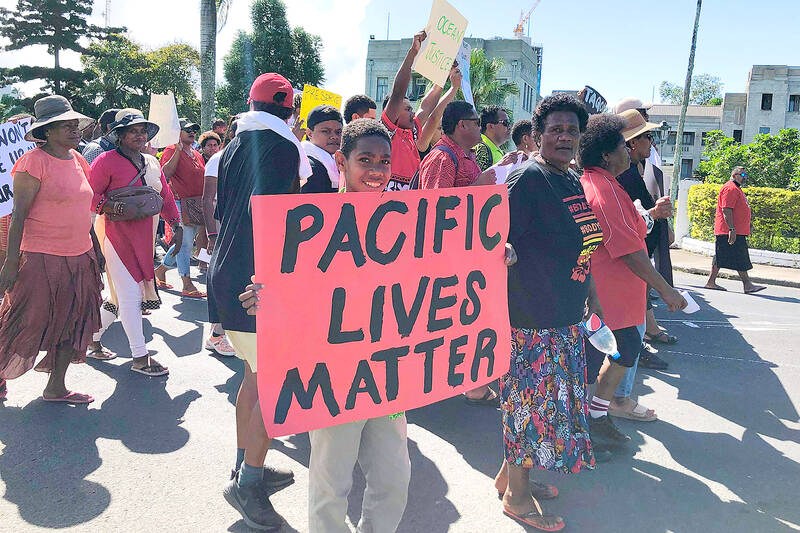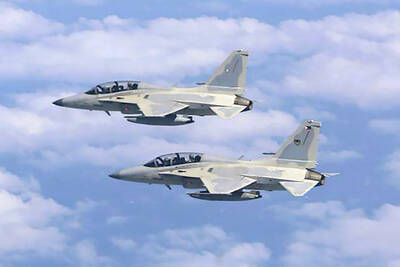China’s Pacific allies from the Solomon Islands’ government to Fiji’s opposition yesterday echoed Beijing’s criticism of Japan releasing wastewater from its disaster-hit Fukushima Dai-ichi nuclear plant.
Treated wastewater is to be released into the Pacific Ocean over decades in a plan endorsed by the International Atomic Energy Agency (IAEA), but China has issued a furious response, and its allies in the Pacific have backed that criticism despite safety assurances from Japan and the IAEA.
Solomon Islands Prime Minister Manasseh Sogavare — who has delayed elections and scolded Western powers while embracing Beijing’s checkbook diplomacy — issued a “strong statement against Japan’s decision.”

Photo: AFP
The water release “has an impact on our people, ocean, economy and livelihood,” Sogavare said.
There was a similar message in the Fijian capital, Suva, where a rare protest attracted hundreds.
Demonstrators carried placards saying “Nuclear-free sea” and “Pacific Lives Matter.”
The protest was promoted by FijiFirst, an opposition party whose leader, former Fijian prime minister Voreqe Bainimarama, courted closer ties with China while in office.
The party accused Fiji’s government of “failing future generations by allowing Japan to dump its nuclear waste into our ocean.”
Other leaders in the region appeared to be convinced by the safety assessments.
“Japan has reassured the region that the water has been treated,” said Cook Islands Prime Minister Mark Brown, who is chair of the Pacific Islands Forum, a regional bloc. “I believe that the discharge meets international safety standards.”
China has repeatedly and strongly criticized the release plan, banned Japanese seafood imports and cast doubt on the expert assessments that concluded the operation poses no harm to the environment.
Nigel Marks, a physics professor at Australia’s Curtin University, said the released water contains negligible amounts of radioactive tritium.
“The Pacific Ocean contains 8,400 grams of pure tritium, while Japan will release 0.06 grams of tritium every year,” Marks said. “The minuscule amount of extra radiation won’t make the tiniest jot of difference.”
Regardless of the data, the Fukushima release has created a political opening for Beijing, said Mihai Sora, a former Australian diplomat who is now with the Lowy Institute in Sydney.
Japan has “done a lot of diplomacy to win over as many Pacific leaders as they can,” but “almost universally this will be an unpopular decision among Pacific communities,” Sora said.
“You can imagine Beijing using its diplomatic access to encourage some of its partners to speak out about this strongly, because it serves Beijing’s interests,” he said.
As well as fears about damaging vital fish supplies and sensitive marine ecosystems, the Fukushima water release has caused disquiet in a region where nuclear issues are highly sensitive.
For decades, major powers including the US, Britain and France used the sparsely populated South Pacific to test atomic weapons — with consequences that linger to this day.
Meanwhile, samples of seawater taken following the release showed radioactivity levels well within safe limits, data provided yesterday by operator Tokyo Electric Power Co showed (TEPCO).
“We confirmed that the analyzed value is equal to the calculated concentration and that the analyzed value is below 1,500” becquerels per liter, TEPCO spokesman Keisuke Matsuo said a day after the release began.
The national safety standard is 60,000 becquerels per liter.

OPTIMISTIC: A Philippine Air Force spokeswoman said the military believed the crew were safe and were hopeful that they and the jet would be recovered A Philippine Air Force FA-50 jet and its two-person crew are missing after flying in support of ground forces fighting communist rebels in the southern Mindanao region, a military official said yesterday. Philippine Air Force spokeswoman Colonel Consuelo Castillo said the jet was flying “over land” on the way to its target area when it went missing during a “tactical night operation in support of our ground troops.” While she declined to provide mission specifics, Philippine Army spokesman Colonel Louie Dema-ala confirmed that the missing FA-50 was part of a squadron sent “to provide air support” to troops fighting communist rebels in

PROBE: Last week, Romanian prosecutors launched a criminal investigation against presidential candidate Calin Georgescu accusing him of supporting fascist groups Tens of thousands of protesters gathered in Romania’s capital on Saturday in the latest anti-government demonstration by far-right groups after a top court canceled a presidential election in the EU country last year. Protesters converged in front of the government building in Bucharest, waving Romania’s tricolor flags and chanting slogans such as “down with the government” and “thieves.” Many expressed support for Calin Georgescu, who emerged as the frontrunner in December’s canceled election, and demanded they be resumed from the second round. George Simion, the leader of the far-right Alliance for the Unity of Romanians (AUR), which organized the protest,

ECONOMIC DISTORTION? The US commerce secretary’s remarks echoed Elon Musk’s arguments that spending by the government does not create value for the economy US Secretary of Commerce Howard Lutnick on Sunday said that government spending could be separated from GDP reports, in response to questions about whether the spending cuts pushed by Elon Musk’s Department of Government Efficiency could possibly cause an economic downturn. “You know that governments historically have messed with GDP,” Lutnick said on Fox News Channel’s Sunday Morning Futures. “They count government spending as part of GDP. So I’m going to separate those two and make it transparent.” Doing so could potentially complicate or distort a fundamental measure of the US economy’s health. Government spending is traditionally included in the GDP because

Hundreds of people in rainbow colors gathered on Saturday in South Africa’s tourist magnet Cape Town to honor the world’s first openly gay imam, who was killed last month. Muhsin Hendricks, who ran a mosque for marginalized Muslims, was shot dead last month near the southern city of Gqeberha. “I was heartbroken. I think it’s sad especially how far we’ve come, considering how progressive South Africa has been,” attendee Keisha Jensen said. Led by motorcycle riders, the mostly young crowd walked through the streets of the coastal city, some waving placards emblazoned with Hendricks’s image and reading: “#JUSTICEFORMUHSIN.” No arrest